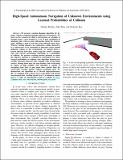| dc.contributor.author | Richter, Charles Andrew | |
| dc.contributor.author | Ware, John W. | |
| dc.contributor.author | Roy, Nicholas | |
| dc.date.accessioned | 2018-05-31T12:51:27Z | |
| dc.date.available | 2018-05-31T12:51:27Z | |
| dc.date.issued | 2014-09 | |
| dc.identifier.isbn | 978-1-4799-3685-4 | |
| dc.identifier.uri | http://hdl.handle.net/1721.1/116008 | |
| dc.description.abstract | We present a motion planning algorithm for dynamic vehicles navigating through unknown environments. We focus on the scenario in which a fast-moving car attempts to navigate from a start location to a set of goal coordinates in minimum time with no prior information about the environment, building a map in real time from onboard sensor data. Whereas existing planners for exploration confine themselves to a conservative set of constraints to guarantee safety around unknown regions of the environment, we instead learn a hazard function from data, which maps the vehicle's dynamic state and current environment knowledge to a probability of collision. We perform receding horizon planning in which the objective function is evaluated in expectation over those learned probabilities of collision. Our algorithm demonstrates sensible emergent behaviors, like swinging wide around blind corners, slowing down near the map frontier, and accelerating in regions of high visibility. Our algorithm is capable of navigating from start to goal much more quickly than the conservative baseline planner without sacrificing safety. We demonstrate our algorithm on a 1:8-scale high-performance RC car equipped with a planar laser range-finder and inertial measurement unit, reaching speeds of 4m/s in unknown, indoor spaces. A video of experimental results is available at: http: //groups.csail.mit.edu/rrg/nav-learned-prob-collision. | en_US |
| dc.publisher | Institute of Electrical and Electronics Engineers (IEEE) | en_US |
| dc.relation.isversionof | http://dx.doi.org/10.1109/ICRA.2014.6907760 | en_US |
| dc.rights | Creative Commons Attribution-Noncommercial-Share Alike | en_US |
| dc.rights.uri | http://creativecommons.org/licenses/by-nc-sa/4.0/ | en_US |
| dc.source | MIT Web Domain | en_US |
| dc.title | High-speed autonomous navigation of unknown environments using learned probabilities of collision | en_US |
| dc.type | Article | en_US |
| dc.identifier.citation | Richter, Charles, John Ware, and Nicholas Roy. “High-Speed Autonomous Navigation of Unknown Environments Using Learned Probabilities of Collision.” 2014 IEEE International Conference on Robotics and Automation (ICRA) (May 2014). | en_US |
| dc.contributor.department | Massachusetts Institute of Technology. Computer Science and Artificial Intelligence Laboratory | en_US |
| dc.contributor.department | Massachusetts Institute of Technology. Department of Aeronautics and Astronautics | en_US |
| dc.contributor.department | Massachusetts Institute of Technology. Department of Mechanical Engineering | en_US |
| dc.contributor.mitauthor | Richter, Charles Andrew | |
| dc.contributor.mitauthor | Ware, John W. | |
| dc.contributor.mitauthor | Roy, Nicholas | |
| dc.relation.journal | 2014 IEEE International Conference on Robotics and Automation (ICRA) | en_US |
| dc.eprint.version | Author's final manuscript | en_US |
| dc.type.uri | http://purl.org/eprint/type/ConferencePaper | en_US |
| eprint.status | http://purl.org/eprint/status/NonPeerReviewed | en_US |
| dc.date.updated | 2018-04-10T14:36:30Z | |
| dspace.orderedauthors | Richter, Charles; Ware, John; Roy, Nicholas | en_US |
| dspace.embargo.terms | N | en_US |
| dc.identifier.orcid | https://orcid.org/0000-0003-3765-2021 | |
| dc.identifier.orcid | https://orcid.org/0000-0002-5867-4900 | |
| dc.identifier.orcid | https://orcid.org/0000-0002-8293-0492 | |
| mit.license | OPEN_ACCESS_POLICY | en_US |
